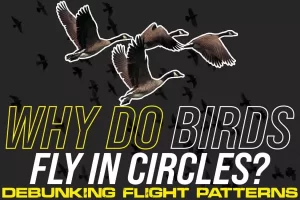Why Do Birds Fly In Circles? Debunking Flight Patterns
Share
Understanding the flight pattern of certain species of birds can, at times, be challenging. While some species migrate to avoid adverse climates, some fly in nearly inexplicable patterns.
The behavior of these birds can be quite difficult to interpret. They have been puzzling even to seasoned animal behavior experts.
Circular flight motion is quite common in birds. It is fascinating to observe birds fly around in perfect circles as if they choreographed the patterns. This motion of flight has been observed in nearly every species of bird. Let us find out why they tend to do this from time to time.
Why do birds fly in circles?
There are several reasons why birds fly in circles. The main reason is to conserve energy. When the sun’s rays heat the ground, it causes pockets of warm air to rise. The warm air rises as it is less dense. Rising warm air causes an updraft effect. Birds can take advantage of the rising heated air by flying in circles and conserving energy.
Other Reasons For Circular Flight
As mentioned earlier, taking advantage of thermal radiation isn’t the only reason for circular flight. Here are other reasons why birds tend to fly in circles:
1. Surveying for resources
Birds tend to fly in circles to map out the resources that fall within a certain radius of land. This is an effective method of gathering information, as they can survey large tracks of land at a time. Some of the resources may include food, water, dry grass patches, among others.
Carnivorous birds have evolved to have great eyesight and an excellent sense of smell. They can detect prey from far distances by isolating the search area by flying in circles.
2. Throwing off predators
Carnivorous birds are adept in hunting targets on the ground. This is, however, quite difficult to replicate in the air. Part of the reason this is the case is that birds use circular flight patterns to confuse the hunters.
It is quite distracting for hunter birds to focus on prey that uses sporadic and circular flight patterns. It has further been made difficult by the fact that prey tends to fly in a flock. It is therefore difficult for predatory birds to focus on a single bird while they hunt.
3. Gathering flock
Birds may fly in circles to gather other birds. Circular flight acts as an invitation to birds from the same species to join in. This is common for birds that migrate to escape harsh climatic conditions.
Birds must migrate in numbers to conserve as much energy as they can during flight. If the numbers are enough, they can fly in streamlined patterns, which helps reduce drag; thus, they spend less energy moving and saving their scarce reserves.
The more energy they conserve, the greater the distance they are likely to cover. Flying in the V formation also enables birds to fly faster.
4. Navigational orientation
To get a general sense of direction, some birds fly in circular patterns. This is common for birds that are moving into a new environment. Circular flight assists the birds in accurately mapping out the environment to avoid flying over the same area.
Hawks, in particular, have been known to utilize updraft to map the routes that they use during migration season. Their great vision enables them to survey large chunks of land by flying above them quickly.
Loss Of Flight In Certain Species
Flight is, without a doubt, one of the most desirable and useful evolutionary traits that birds have. It has enabled the avian species to survive and proliferate as a species. Other avian species have, out of necessity, lost their ability to fly.
Birds that lost their ability to fly could gain other evolutionary characteristics that enabled them to survive.
Loss of flight is believed to occur in species of birds that settle in areas without natural predators. This phenomenon can be observed in species like penguins.
The size was also a telling factor for some avian species losing their ability to fly. Birds such as ostriches fit into this category.
How Do Birds Achieve Flight?
It is fascinating thinking about how birds are capable of achieving flight. They possess the right set of adaptations that all other species lack. Here are some of the main reasons why birds are capable of archiving flight.
1. Body shape
Birds are streamlined. Being streamlined enables them to move through the air with minimal drag. During the flight, they can slice through the air as they encounter minimum friction. This also enables them to archive the required velocity to sustain flight over a long period.
2. Feathers
Feathers are important during a bird’s flight. They enable birds to remain buoyant and assist in gliding. They are also light and enable the bird to channel the flow of air currents underneath their bodies.
3. Bone density
Birds of flight tend to have less dense bones. They also have fewer bones. This is important as it assists in weight reduction. Having less dense bones also reduces the energy required to archive flight. Low bone density also makes flight sustainable for long periods.
4. Wings
Wings enable birds to push through pockets of air and counteract drag. They also enable birds to take advantage of the air underneath, propelling them both vertically and horizontally.
Wings are also gradually curved to take advantage of pressure systems. The underside of the wings has fewer curves in comparison to the upper side. The curvature helps birds to achieve lift without expending a lot of effort.
Common Flight Patterns In Birds
Aside from circular flight, there are many other common patterns that birds have adopted. They vary widely from highly structured to random and erratic. These flight patterns are:
1. Moth-like
The moth-like sequence is a random and completely unstructured pattern of flight. It is characterized by sudden and several changes in direction and speed of flight. This is common in young birds that are just learning to fly or flying for the first time.
The moth-like pattern is also commonly used by nectar birds when feeding.
2. Undulating
This pattern of flight is rhythmical and quite predictable. Repeated troughs and peaks characterize the pattern.
The bird glides in an upward curve and downward in a controlled and gentle dip. This happens in alternating sequences.
This flight pattern is quite energy-efficient as the wings tend to stay in a resting motion through the downward glides. The bird is streamlined and quite aerodynamic; therefore, the downward glides are slow.
3. Flap glide
This flight technique is normally adopted by birds that are flying against a weak current. It is also useful when flying into an uneven pocket of wind moving in the opposite direction. Rapid thrusts and smooth glides characterize it.
The quick thrusts enable the birds to get directional momentum, and the glides assist the bird in resting. This pattern is even and quite predictable.
4. Direct
A direct pattern refers to a motion of flight where the bird moves using consistent wing flaps without a gliding motion. This is common during the initial stages of flight before the bird has built up enough momentum to glide.
The direct pattern is also useful for birds flying against strong wind gusts, as it assists in countering the momentum.
5. Zigzag
The zigzag pattern of flight is unique to birds that are trying to evade capture. Erratic changes along the vertical plane characterize this flight pattern.
The zigzag motion is unpredictable, making it an excellent evasive maneuver for prey and smaller birds.
6. Hovering
This is a common flight technique for small birds. Hovering is notable in the hummingbird and the woodpecker. They can maintain buoyance by rapidly flapping their wings. This is useful for birds when they are trying to navigate obstacles.
Hovering requires a lot of energy and is only possible in quick and short bursts. Larger birds like stock are incapable of hovering due to their weight.
7. Bounding flight
Bounding flight is common in small birds that fly long distances. This technique enables them to move rapidly across large distances.
It entails rapid wing flaps to gain directional momentum. It is then succeeded by the bird tucking its wings against its body to remain streamlined. This is then repeated to keep gathering momentum.
This is also a useful evasive technique as it enables birds to fly very fast.
Conclusion
There are various avian flight patterns. Circular flight is common in every species of bird. Birds fly in circles mainly to take advantage of the updraft. This is caused by terrestrial radiation that causes warm air currents to rise.
The rise of warm air currents is useful as they enable birds to conserve energy during flight.
Birds fly in circles for defense and signal other birds of the same species to join the flock, among other reasons.

















